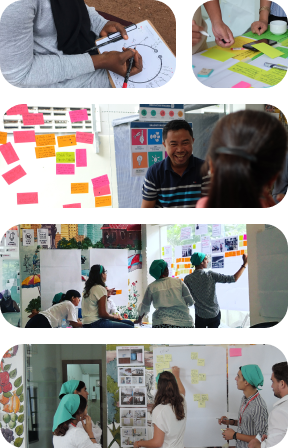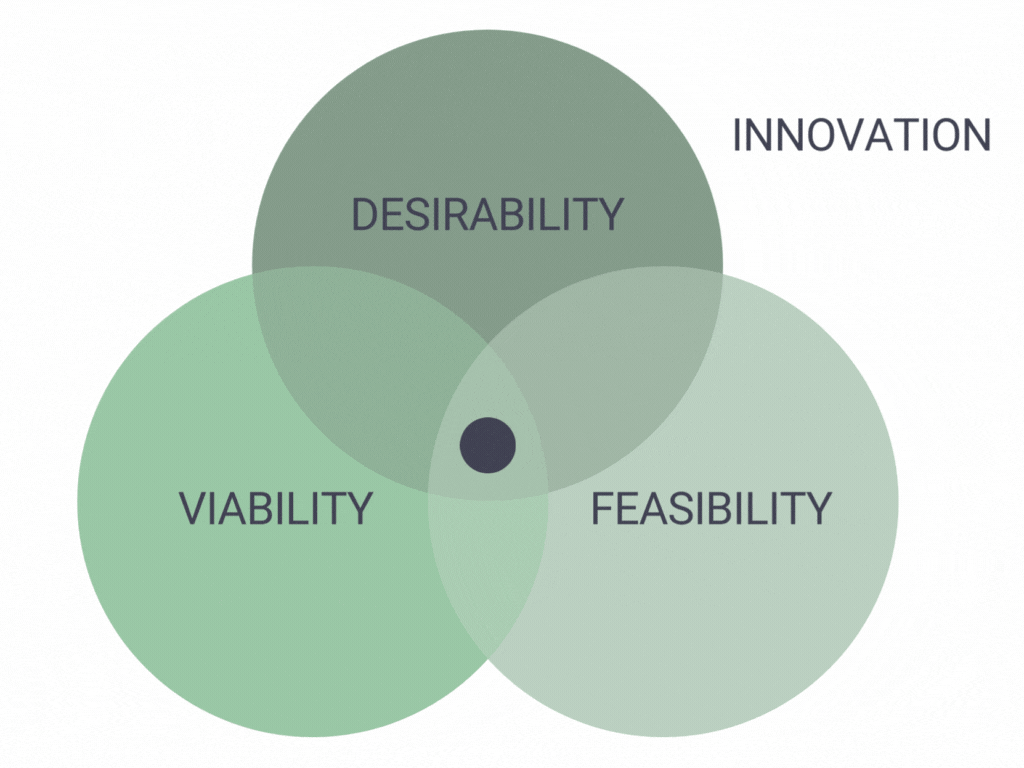Learn about HCD
Human-Centered Design is a creative and iterative problem-solving approach that starts with people to design to context.


Values
Be a good listener
Be participatory
Be creative
Be iterative
Be a good listener
Be participatory
Be creative
Be iterative
Seek to understand the values and perspectives of your end users rather than prescribing a solution that is easier, cheaper, or perceived to be better by you. Be empathetic.

The Three Lenses of HCD
Desirability
(Desired by users)
Feasibility
(Technically feasible)
Viability
(Viable in the market)
Desirability
(Desired by users)
Feasibility
(Technically feasible)
Viability
(Viable in the market)
What do users need and want? What are the drivers and barriers to adoption? What incentives drive their decisions? What is the entire user experience like, from the moment they are exposed to the solution to their ongoing use and maintenance? Who are the users that we are missing? Are we considering minorities and other underrepresented groups?


The HCD Process: DISCOVER, CREATE, DELIVER
DISCOVER
CREATE
DELIVER
DISCOVER
CREATE
DELIVER
First it's important to DISCOVER what people really desire, and reframe the problem through their eyes. This is often through a form of intensive research. This includes observing, listening to and learning about the needs, aspirations, barriers, and motivators of everyone involved. This phase ends with the development of design strategy and clear definition of the problem.
-
Learning from your intended audience arrow_drop_down
In-depth InterviewsUtilize in-depth interviews to develop a comprehensive understanding of WASH practices, behaviors, needs, and aspirations to inform the design of your intervention.
Focus GroupsFocus groups are a helpful way for WASH practitioners to gather insights and test ideas with several people. Focus groups are also a great way to observe group dynamics and organizational challenges within the group or the community.
Card SortingWASH researchers can utilize card sorting to understand how users may prioritize or rank different WASH concepts, such as behaviors, values, or product features and characteristics.
5 Why's TechniqueDifferent communities and people will use and want WASH products and services in distinct ways. The 5 Whys technique is useful for uncovering the root of a person's barriers, motivations and assumptions.
Transect WalkIn WASH interventions such as CLTS, transect walks have been a common tool in identifying community sanitation practices. Yet in HCD, they can be used to help create a common understanding of strengths and challenges in a variety of contexts. They are typically used alongside other data collection tools.
Co-CreationIn WASH, this activity is often used to document the types of latrines, water services or even marketing campaigns that meet their desires. It helps to understand potential trade-offs and willingness to adopt.
-
Turning data and stories into actionable insightsarrow_drop_down
StorytellingAfter a long day of field research, having a semi-structured way to debrief allows for WASH team members to share and capture key findings and insights learned.
TOESAfter a long day of field research, having a semi-structured way to debrief allows for WASH team members to share key findings and insights learned.
Focus GroupsFocus groups are a helpful way for WASH practitioners to gather insights and test ideas with several people. Focus groups are also a great way to observe group dynamics and organizational challenges within the group or the community.
Affinity MappingAfter conducting research and aggregating all researchers’ findings, WASH team members can use the affinity mapping tool to start analyzing their data according to key themes.
Day in the LifeWASH activities and responsibilities affect different types of people quite differently and by understanding the typical day of different types of people, solutions can be designed to best meet the needs of the individuals most directly affected.
Persona TemplateWhile WASH needs can vary person to person, segmenting and summarizing the shared characteristics of different groups in your audience of focus allows project teams to design, test, and implement more impactful solutions.
Journey MappingMapping the barriers your stakeholders experience while performing a job or task is critical for understanding how your WASH program, service, or product can support stakeholders in ways that mean the most to them.
Writing Insight StatementsCreating insight statements allows WASH practitioners to base their ideas and solutions off of a shared understanding of the actual motivation, problems, and challenges that people are experiencing, rather than what practitioners observe or believe to be true.
Stakeholder MappingWASH is influenced by many people, and as the number of stakeholders increases, it becomes increasingly complex to understand them all. Stakeholder mapping helps to visualize a solution that includes all parties.
-
Using insights to identify solution opportunitiesarrow_drop_down
Design Principles & PrioritiesWASH professionals can use design principles and priorities to outline the most important elements of a WASH product or service they wish to design. When formulating and developing their ideas, design principles give form and integrity to the final solution.
How might we'sProblems and challenges encountered in any WASH program can sometimes seem impossible to address. Re-statating them in an intentionally optimistic way using “How Might We” questions stimulates a much-needed creative problem-solving mindset and the positive change you wish for.
Come join our
Events
Lorem ipsum dolor sit amet, consectetur adipiscing elit. Aenean id sapien ornare, fermentum nisi id, faucibus metus.
More events